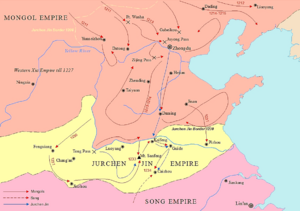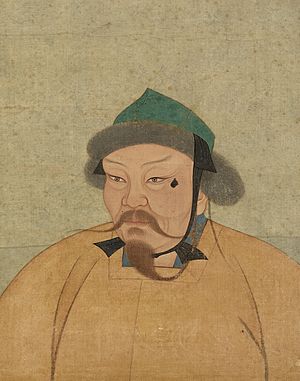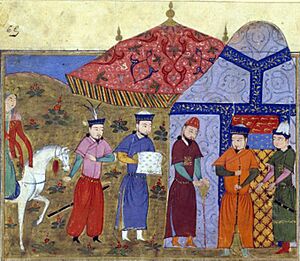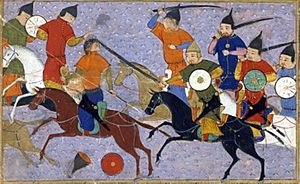Mongol siege of Kaifeng facts for kids
Quick facts for kids Mongol siege of Kaifeng |
|||||||
|---|---|---|---|---|---|---|---|
| Part of the Mongol–Jin War | |||||||
 Mongol Conquest of Jurchen Jin |
|||||||
|
|||||||
| Belligerents | |||||||
| Jin dynasty | Mongol Empire | ||||||
| Commanders and leaders | |||||||
| Emperor Aizong of Jin Cui Li (Han officer who defected to the Mongols) |
Subutai Tolui Ögedei Tang Qing † (Han general) |
||||||
| Strength | |||||||
| 300,000 | 15,000 | ||||||
The Mongol siege of Kaifeng was a major battle that happened between 1232 and 1233. During this time, the powerful Mongol Empire attacked and captured Kaifeng. Kaifeng was the capital city of the Jin dynasty, which was ruled by the Jurchens.
The Mongols and the Jin dynasty had been fighting for almost 20 years. The war started in 1211 because the Jin dynasty refused to become a vassal (a state controlled by another, more powerful state) of the Mongols. Ögedei Khan, the Mongol leader, sent two armies to attack Kaifeng. One army was led by him, and the other by his brother Tolui. Once the armies joined together, the main command was given to Subutai. The Mongol armies reached the walls of Kaifeng on April 8, 1232.
During the siege, the people inside Kaifeng suffered greatly. They ran out of food and many got sick. The Jin soldiers bravely defended their city using new weapons like fire lances and bombs made with gunpowder. These weapons killed and injured many Mongol soldiers. The Jin dynasty tried to make a peace deal, but it failed after a Mongol diplomat was killed. The Jin leader, Emperor Aizong of Jin, secretly left the city and went to a town called Caizhou. General Cui Li was left in charge of Kaifeng. He had the emperor's loyal supporters killed and then quickly surrendered the city to the Mongols. The Mongols entered Kaifeng on May 29, 1233, and took many valuable things. The Jin dynasty finally ended in 1234 after Emperor Aizong died and Caizhou was captured.
Contents
What Led to the Siege?
In 1206, Genghis Khan became the supreme leader, or Khaghan, of the Mongols. He united all the Mongol tribes. At that time, China was split into three main states. In the north, the Jurchen-led Jin dynasty ruled a large area, including Manchuria. To the west, the Tangut-led Western Xia dynasty controlled some parts of western China. In the south, the Song dynasty ruled.
The Mongols first took control of Western Xia in 1210. In the same year, they declared they were no longer a vassal state to the Jin dynasty. The Mongols wanted the rich lands of the Jin. They also remembered that the Jin had killed Ambaghai, an earlier Mongol leader.
In 1211, the Mongols learned that the Jin were suffering from a famine, so they invaded. Genghis Khan led one of the Mongol armies. The Jin tried to prepare by building up their armies and strengthening their cities. However, the Mongols focused on capturing smaller towns and avoiding the heavily fortified big cities. They took goods from the land and then left in 1212.
The Mongols returned in 1213 and attacked Zhongdu, which was the Jin capital at the time. They couldn't break through the city walls in the Battle of Zhongdu. But they scared the Jin emperor into paying them a large amount of money and goods, known as tribute. The Mongols left in 1214. Later that year, the Jin, fearing another attack, moved their capital from Zhongdu to Kaifeng. When the Mongols found out, they attacked Zhongdu again in 1215. The city fell on May 31, and by 1216, the Mongols controlled much of the Jin territory.
Meanwhile, the Jin dynasty faced many rebellions. In Manchuria, a group called the Khitans broke away from the Jin and joined the Mongols. Other rebellions, like the "Red Coats" in Shandong, also weakened the Jin. After Zhongdu fell, the Mongols focused less on the Jin and more on invading Central Asia. The Jin tried to make up for their losses by attacking the Song dynasty in 1217, but this didn't work. The Mongol war against the Jin continued off and on until 1223.
Genghis Khan died in 1227. His successor, Ögedei, started the war against the Jin again in 1230. A Chinese general named Shi Tianze, who had joined the Mongols, helped defeat a large Jin army of 80,000 soldiers.
The Siege of Kaifeng Begins
In 1230, two Mongol armies were sent to capture Kaifeng, which was then called Bianjing. One army was to attack from the north, and the other from the south. Ögedei Khan led the army from Shanxi, and his brother Tolui led the army from Shaanxi. Both Ögedei and Tolui became sick, so they had to give up their command for a while. Ögedei got better, but Tolui died the next year. Subutai took charge of the combined Mongol forces in late 1231 and early 1232. The Mongols reached the Yellow River on January 28, 1232, and began to gather around Kaifeng on February 6. They officially started the siege on April 8.
The Jin leaders tried to end the siege by talking about a peace treaty. They made some progress in the summer of 1232. However, the Jin killed a Mongol diplomat named Tang Qing and his group. This made any further peace talks impossible. The Jin became very desperate. They had used almost every available man in their empire to defend Kaifeng or fight the Mongols.
While the talks were happening, a terrible plague spread through the city, killing many people. Starvation was also a huge problem. The food supplies in Kaifeng were quickly running out, even after they took food from everyone. People inside the city also started to suspect each other of being traitors, and some were even executed.
The city's defenses did not fall apart right away. The Jin held out for many months. The Jin emperor managed to escape in late 1232. He left General Cui Li in charge of the city. The emperor reached Guide in Henan on February 26, 1233, and then Caizhou on August 3. The emperor's escape greatly lowered the spirits of the soldiers defending Kaifeng. After the emperor left, Cui Li ordered the killing of those who were still loyal to the emperor. He realized that they could not hold out much longer. So, he offered to surrender to the Mongols. Cui Li opened the gates of Kaifeng, and the Mongols entered the city on May 29. Cui Li was later killed in a personal fight.
When the city fell, the Mongols took many valuable things. However, unlike many sieges at that time, they allowed trade. The richest people in Kaifeng sold their fancy belongings to Mongol soldiers to get the food they desperately needed. Male members of the Jin royal family who were in the city were captured and killed. All the emperor's wives, including the empress dowager, were captured and taken north.
New Military Technology
Historians find the siege of Kaifeng very important for understanding military technology. We know many details about the siege because a Jin official who was in the city wrote a detailed account. The Jin soldiers used explosives, which were launched by large machines called trebuchets.
Here is how the bombs were used: First, a soldier would light a fuse. Then, the trebuchet's rope was pulled, throwing the bomb into the air. When the bomb landed, it exploded loudly. This explosion was strong enough to damage armor. Sometimes, the explosion would even start a fire on the ground, which could burn soldiers. These early bombs were not perfect; sometimes they didn't explode, or they exploded too early.
Mongol soldiers tried to protect themselves from these bombs. They dug trenches (long, narrow ditches) leading up to the city. They covered these trenches with shields made of cowhide. But the Jin had a clever trick. They would lower their "thunder crash bombs" on iron chains directly into the trenches. When these bombs exploded, they blew up the cowhide shields and the Mongol soldiers hiding beneath them.
The Jin foot soldiers also used fire lances. A fire lance was a spear with a tube of gunpowder attached to it. This gunpowder mix contained sulfur, charcoal, saltpeter, and even ground porcelain and iron filings. When lit, a flame shot out from the lance, reaching up to three meters (about 10 feet). The soldiers carried a small iron box with hot material to light the weapon. After the gunpowder was used up, the fire lance could be used like a normal spear, or a new tube of gunpowder could be attached.
The bombs and fire lances were the only weapons of the Jin that the Mongols truly feared. The Jin used a lot of gunpowder. It's not clear if the Mongols had gunpowder before this battle. Some historians believe both sides had it, while others think only the Jin used it. The Mongols used their own catapults to throw large stones or gunpowder bombs at the Jin city walls. This caused damage and scared the Jin soldiers.
What Happened Next?
The siege of Kaifeng badly hurt the Jin dynasty, but it didn't completely destroy it. Emperor Aizong had escaped, but he was left with very little power or resources. He sent his diplomats to ask the nearby Song Dynasty for help. He warned them that if the Jin fell, the Mongols would surely invade the Song next. He asked for supplies.
However, the Song dynasty refused to help. The Song had fought many wars against the Jin and still resented them for taking northern China years earlier. Instead of helping the Jin, the Song decided to join forces with the Mongols. They worked together to capture the last cities still held by the Jin.
In December 1233, the Mongols attacked Caizhou, the town where Emperor Aizong had fled from Kaifeng. The emperor could not escape the besieged town, so he took his own life. On February 9, 1234, the Mongols broke through Caizhou's defenses. Emperor Mo, who was supposed to be Emperor Aizong's successor, was also in Caizhou and was killed in battle soon after. His rule lasted less than two days. The Jin dynasty officially ended with the fall of Caizhou.
Just one year after the Jin dynasty ended, Emperor Aizong's warning came true. The Mongol conquest of the Song dynasty began, showing that the Mongols were indeed a threat to everyone.
How Mongols Treated Royal Families
Historian Patricia Buckley Ebrey has noted that the Mongol Yuan dynasty was very harsh towards the Jurchen Wanyan royal family of the Jin dynasty. They killed hundreds of them. They also treated the Tangut emperor of Western Xia very harshly when they defeated him earlier.
However, the Mongols were much kinder to the Han Chinese Zhao royal family of the Southern Song dynasty. This was very different from how the Jurchens had treated the Song royals during the Jingkang incident years before. The Mongols spared both the Southern Song royals in their capital city, Hangzhou, including Emperor Gong of Song and his mother. They also did not attack the civilians in the city, allowing them to continue their normal lives. The Mongols even hired back some Southern Song officials.
The Mongols did not take the Southern Song palace women for themselves. Instead, they arranged for Han Chinese artisans in Shangdu to marry them. The Mongol emperor Kublai Khan even gave a Mongol princess from his own family to the surrendered Han Chinese Southern Song Emperor Gong of Song as a wife. They had a son together.
In contrast, during the Mongol siege of Kaifeng in 1233, the Mongols and the Han Chinese who had joined them against the Jin killed the male members of the Jin Jurchen Wanyan Imperial family. They took the Jin Jurchen Wanyan royal women, including the emperor's wives and princesses, to Mongolia as war prizes. Earlier, during the Battle of Zhongdu, Genghis Khan had forced the Jin dynasty to give the daughter of a former Jin emperor, the Jin Jurchen Wanyan Princess of Qi, to him as a concubine.




